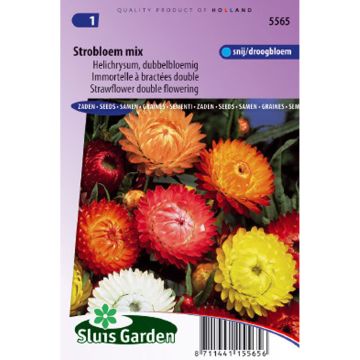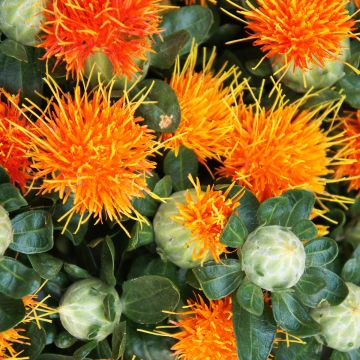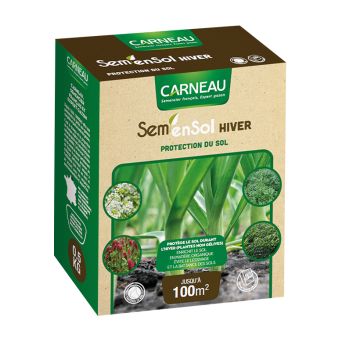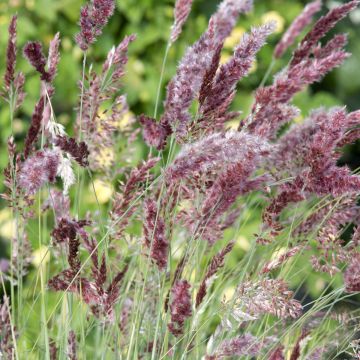

Gilia tricolor Felicitas - Bird's Eye seeds
Gilia tricolor Felicitas - Bird's Eye seeds
Gilia tricolor Felicitas
Bird's Eye, Bird's Eyes, Bird's Eye Gilia, Tricolor Gilia
This item cannot be shipped to the selected country
Dispatch by letter from €3.90
More information
Schedule delivery date,
and select date in basket
This plant carries a 6 months recovery warranty
More information
We guarantee the quality of our plants for a full growing cycle, and will replace at our expense any plant that fails to recover under normal climatic and planting conditions.
Seed-only orders are dispatched by sealed envelope. The delivery charge for seed-only orders is €3.90.
Does this plant fit my garden?
Set up your Plantfit profile →
Description
Gilia tricolor Felicitas is a charming, easy to grow and beautifully coloured annual, often underused in our gardens despite its endless flowering and tendency to self-seed just like nigellas. Its small bells of variable colour ranging from white to pink to mauve and violet have a dark violet spotted throat that provides a striking contrast and will attract bees. It will flower from spring to late summer depending on the sowing date and climate. It is easy-to-grow in well-drained soil, essential in a meadow, where it will thrive alongside other wild annual plants. Graceful and versatile, it is also an excellent companion for terrace flowers, in flower pots and containers.
Gilia tricolor Felicitas is a plant in the polemoniaceae family, just like Phlox and Polemonium. Its ancestor, also known as "Bird's Eyes", is native to California, where entire slopes are often covered with its eye-catching, tricoloured flowers. It is a herbaceous annual plant, with a life cycle of only a few months. It forms a branched clump that reaches an average height of 60 cm (24in) and a width of 20 cm (8in), composed of leafy stems. The delicate foliage consists of entire leaves divided into thin, vibrant green lobes. In spring or summer (July, August, September), stems appear at their tips with solitary flowers or flowers clustered in small panicles. These are 1.5 cm (1in) in diameter flowers, with 5 petals fused at the base. The prominent blue stamens are arranged around the pale yellow throat, on a circle of dark violet. They attract numerous pollinating insects. Flowering is followed by numerous seeds that germinate easily where they fall.
Gilia tricolor Felicitas can be sown directly in place, it is relatively hardy and tolerates heat and summer drought well as it adapts its vegetative cycle to the climate. In a wildflower bed or meadow, it can be paired with cosmos, nigellas, California poppies, phacelia, sainfoin, Buenos Aires verbena and clarkias. It fits well in dry beds, alongside shrubby salvias, toadflaxes, and grasses like stipa tenuifolia or Muhlenbergia capillaris. It is a spontaneous flower, charming in pots with nemophilas, petunias, and florist geraniums...
Report an error about the product description
Flowering
Foliage
Plant habit
Botanical data
Gilia
tricolor
Felicitas
Polemoniaceae
Bird's Eye, Bird's Eyes, Bird's Eye Gilia, Tricolor Gilia
North America
Other Flower seeds A to Z
Planting and care
Sow Gilia tricolor Felicitas seeds in spring, after the last frost, or in late summer in milder climates, directly in place. Broadcast sow, covering the seeds with 6mm (0in) of fine soil. Germination will take 8 to 15 days. The plant is hardy in zone 8, and young plants that germinate in early autumn will easily withstand milder winters if they are planted in light and well-drained soil.
Gilia tricolor thrives in well-drained soils. It adjusts its vegetative cycle to the climate, like nigella. Its flowers will be more beautiful in the sun and in soil that remains slightly moist. In heavy soil, it is a good idea to mix river sand or gravel into the planting soil and loosen the soil to a depth of 50cm (20in).
Sowing period
Intended location
This item has not been reviewed yet - be the first to leave a review about it.
Flower seeds
Haven't found what you were looking for?
Hardiness is the lowest winter temperature a plant can endure without suffering serious damage or even dying. However, hardiness is affected by location (a sheltered area, such as a patio), protection (winter cover) and soil type (hardiness is improved by well-drained soil).

Photo Sharing Terms & Conditions
In order to encourage gardeners to interact and share their experiences, Promesse de fleurs offers various media enabling content to be uploaded onto its Site - in particular via the ‘Photo sharing’ module.
The User agrees to refrain from:
- Posting any content that is illegal, prejudicial, insulting, racist, inciteful to hatred, revisionist, contrary to public decency, that infringes on privacy or on the privacy rights of third parties, in particular the publicity rights of persons and goods, intellectual property rights, or the right to privacy.
- Submitting content on behalf of a third party;
- Impersonate the identity of a third party and/or publish any personal information about a third party;
In general, the User undertakes to refrain from any unethical behaviour.
All Content (in particular text, comments, files, images, photos, videos, creative works, etc.), which may be subject to property or intellectual property rights, image or other private rights, shall remain the property of the User, subject to the limited rights granted by the terms of the licence granted by Promesse de fleurs as stated below. Users are at liberty to publish or not to publish such Content on the Site, notably via the ‘Photo Sharing’ facility, and accept that this Content shall be made public and freely accessible, notably on the Internet.
Users further acknowledge, undertake to have ,and guarantee that they hold all necessary rights and permissions to publish such material on the Site, in particular with regard to the legislation in force pertaining to any privacy, property, intellectual property, image, or contractual rights, or rights of any other nature. By publishing such Content on the Site, Users acknowledge accepting full liability as publishers of the Content within the meaning of the law, and grant Promesse de fleurs, free of charge, an inclusive, worldwide licence for the said Content for the entire duration of its publication, including all reproduction, representation, up/downloading, displaying, performing, transmission, and storage rights.
Users also grant permission for their name to be linked to the Content and accept that this link may not always be made available.
By engaging in posting material, Users consent to their Content becoming automatically accessible on the Internet, in particular on other sites and/or blogs and/or web pages of the Promesse de fleurs site, including in particular social pages and the Promesse de fleurs catalogue.
Users may secure the removal of entrusted content free of charge by issuing a simple request via our contact form.
The flowering period indicated on our website applies to countries and regions located in USDA zone 8 (France, the United Kingdom, Ireland, the Netherlands, etc.)
It will vary according to where you live:
- In zones 9 to 10 (Italy, Spain, Greece, etc.), flowering will occur about 2 to 4 weeks earlier.
- In zones 6 to 7 (Germany, Poland, Slovenia, and lower mountainous regions), flowering will be delayed by 2 to 3 weeks.
- In zone 5 (Central Europe, Scandinavia), blooming will be delayed by 3 to 5 weeks.
In temperate climates, pruning of spring-flowering shrubs (forsythia, spireas, etc.) should be done just after flowering.
Pruning of summer-flowering shrubs (Indian Lilac, Perovskia, etc.) can be done in winter or spring.
In cold regions as well as with frost-sensitive plants, avoid pruning too early when severe frosts may still occur.
The planting period indicated on our website applies to countries and regions located in USDA zone 8 (France, United Kingdom, Ireland, Netherlands).
It will vary according to where you live:
- In Mediterranean zones (Marseille, Madrid, Milan, etc.), autumn and winter are the best planting periods.
- In continental zones (Strasbourg, Munich, Vienna, etc.), delay planting by 2 to 3 weeks in spring and bring it forward by 2 to 4 weeks in autumn.
- In mountainous regions (the Alps, Pyrenees, Carpathians, etc.), it is best to plant in late spring (May-June) or late summer (August-September).
The harvesting period indicated on our website applies to countries and regions in USDA zone 8 (France, England, Ireland, the Netherlands).
In colder areas (Scandinavia, Poland, Austria...) fruit and vegetable harvests are likely to be delayed by 3-4 weeks.
In warmer areas (Italy, Spain, Greece, etc.), harvesting will probably take place earlier, depending on weather conditions.
The sowing periods indicated on our website apply to countries and regions within USDA Zone 8 (France, UK, Ireland, Netherlands).
In colder areas (Scandinavia, Poland, Austria...), delay any outdoor sowing by 3-4 weeks, or sow under glass.
In warmer climes (Italy, Spain, Greece, etc.), bring outdoor sowing forward by a few weeks.





















































